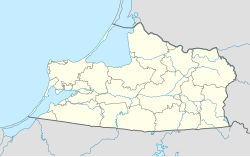|
Gvardeyskoye, Kaliningrad Oblast
Gvardeyskoye (Russian: Гварде́йское, Lithuanian: Miulhauzenas, German: Mühlhausen (Kreis Preußisch Eylau), Polish: Młynary) is a rural locality (a settlement) in Bagrationovsky District of Kaliningrad Oblast, Russia, located approximately 10 kilometers (6.2 mi) north of Bagrationovsk, the administrative center of the district, and 25 kilometers (16 mi) south of Kaliningrad, the administrative center of the oblast. HistoryIt was founded by the Teutonic Knights in the Old Prussian region of Natangia as a location of a mill (mühle means a mill) and a church, first mentioned in 1372. In 1454, the region was incorporated by King Casimir IV Jagiellon to the Kingdom of Poland upon the request of the anti-Teutonic Prussian Confederation.[4] After the subsequent Thirteen Years' War, since 1466, it formed part of Poland as a fief held by the Teutonic Order,[5] and then held by Ducal Prussia after the secularization of the Order in 1525. It was given as a pawn by the Order to Daniel von Kunheim in 1474. The laird Georg von Kunheim, a student at Wittenberg, married Martin Luther's youngest daughter Margarethe Luther in 1555; she died in Mühlhausen in 1570. Two paintings of Luther and his wife Katharina von Bora by Lucas Cranach existed at the church up to 1945, as well as the original summons of Martin Luther by Emperor Charles V to the Diet of Worms and an original letter, written by Luther. The settlement became a part of the Kingdom of Prussia in 1701, and from 1871 it was also part of Germany. In 1643, Mühlhausen came into the property of the von Kalckstein family until 1826, also as advowson of the Church.[clarification needed] Conquered by the Red Army during World War II, Mühlhausen was transferred from Germany to the Soviet Union according to the 1945 Potsdam Conference and had its German population expelled, also in accordance to the Potsdam Conference. It was given its present name by the Soviets. The formerly ruined church was rebuilt after 1994. Population
Notable people
References
Bibliography
External linksWikimedia Commons has media related to Gvardeyskoye, Kaliningrad Oblast.
|
||||||||||||||||||||||||||||||||||




